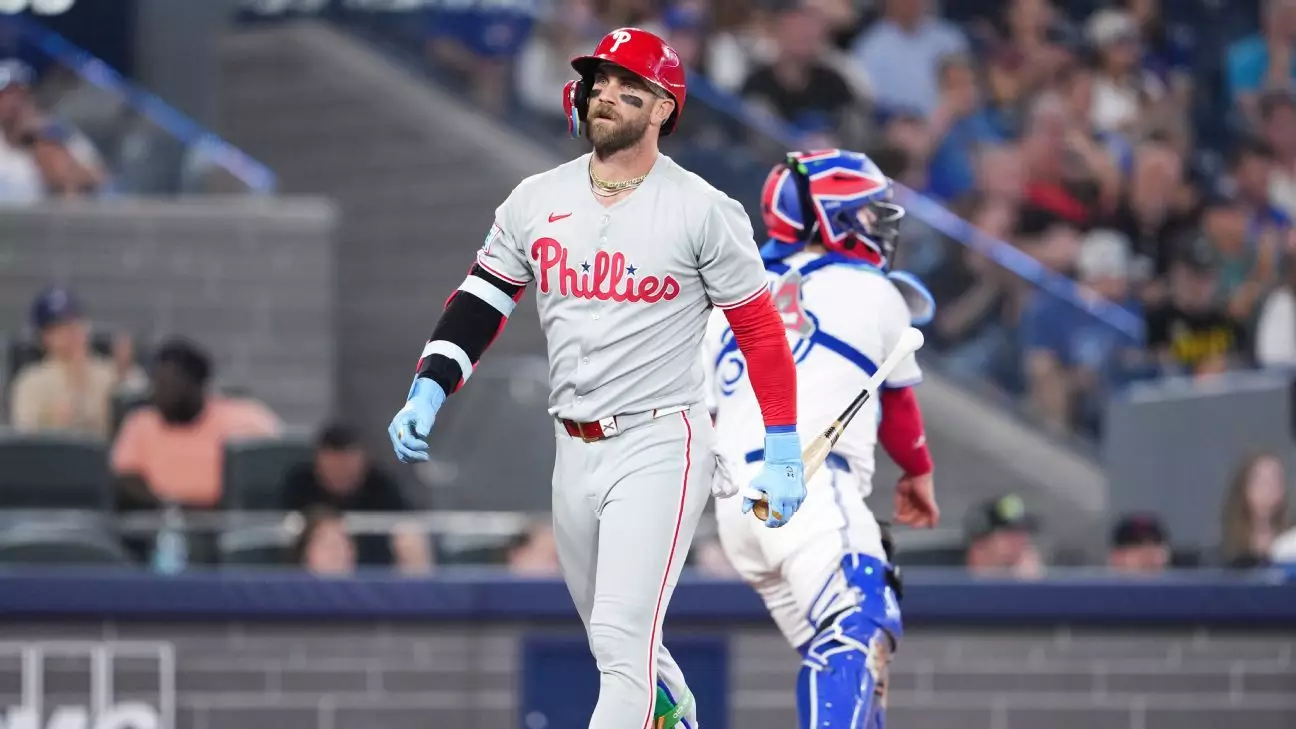The saga of Bryce Harper’s recent wrist injury reads less like a setback and more like a testament to the grit and resilience required at baseball’s highest level. Fans witnessed the Phillies’ star slugger battle persistent inflammation in his right wrist—a nagging issue that stretched from last season well into this year. Unlike many athletes who might rush back prematurely, Harper’s approach was methodical: when he realized the wrist had plateaued in healing despite rest and treatment, he chose to return. This decision wasn’t merely about being available but about bringing his best possible form to the field.
Harper’s return was marked not by reckless optimism but by an honest assessment. “I didn’t think I was going to take any other steps forward,” he admitted shortly before Monday’s game against the Padres. This level of self-awareness and honesty about physical limits often goes unnoticed in the spotlight but is crucial for sustained athletic success. Harper’s cautious yet committed comeback underscores a broader truth in professional sports: managing injuries is as much about mental resolve and timing as it is about physical healing.
Impact on Team Dynamics
The Phillies have faced an intriguing challenge in Harper’s absence. Although the team maintained an almost balanced performance (13-14 without him), underpinning their NL East lead, it’s clear that his presence carries weight beyond statistics. Harper’s multifaceted skill set—combining power hitting, speed on bases, and defensive versatility—makes him irreplaceable. Yet, what’s particularly interesting is how seamlessly the Phillies managed to fill his role with promising talent like Otto Kemp, who’s earned his spot through solid performances since being called up.
Kemp’s ability to cover multiple positions—third base, outfield, and right-handed bat—offers the Phillies flexibility, which might be critical given Harper’s day-to-day wrist management. The organization’s willingness to promote and rely on young talent reflects a healthy balance of patience and competitiveness. Still, the return of Harper introduces a fascinating dilemma for the coaching staff: How to integrate a veteran with an injury history into a lineup now adjusted to a rising rookie’s contributions?
Questions Loom Over Playing Time and Roles
Manager Rob Thomson’s cautious stance on Harper’s status highlights a broader issue in modern sports—the challenge of managing elite athletes’ health over long, grueling seasons. Thomson’s ‘day-to-day’ approach captures the uncertainty but also unwillingness to rush Harper back excessively. Meanwhile, the question of Harper’s role in the lineup remains unresolved, especially with Kyle Schwarber excelling as the designated hitter with 25 homers this season.
Harper’s ability to contribute both offensively and defensively means the Phillies must carefully choreograph lineups to maximize production while minimizing risk to his wrist. It’s notable that Harper himself hasn’t dismissed the DH role, signaling a pragmatic outlook: prioritizing his long-term impact over traditional stubbornness about on-field positioning. This flexibility is a sign of maturity and team-first mentality, qualities essential for a player who shoulders enormous expectations tied to his multimillion-dollar contract.
The Weight of Legacy and Future Expectations
Harper’s journey is also a narrative about legacy. Entering the seventh year of his landmark $330 million contract, he carries the hopes of a fan base hungry for sustained success and another deep playoff run. His accolades—a two-time National League MVP, eight-time All-Star, and the 2022 NLCS MVP—only add to the pressure. His recent wrist issues juxtaposed with his history of clutch performances highlight the thin line elite athletes walk between dominance and vulnerability.
Moreover, Harper’s season statistics—.258 batting average, nine home runs, 34 RBIs, and eight stolen bases in 57 games—reflect a player still effective despite physical impediments. This speaks volumes about his talent and competitive spirit. Harper refuses to be diminished by injury narratives that often shadow aging or high-profile players. Instead, he’s consciously managing his comeback with a blend of realism and determination, which could serve as a blueprint for others navigating similar hurdles.
—
The saga of Bryce Harper’s wrist injury and return is more than a sports injury story. It’s a layered illustration of leadership, adaptability, and the relentless pursuit of excellence amid adversity—a reflection of what it truly means to be a champion in today’s game.


Leave a Reply